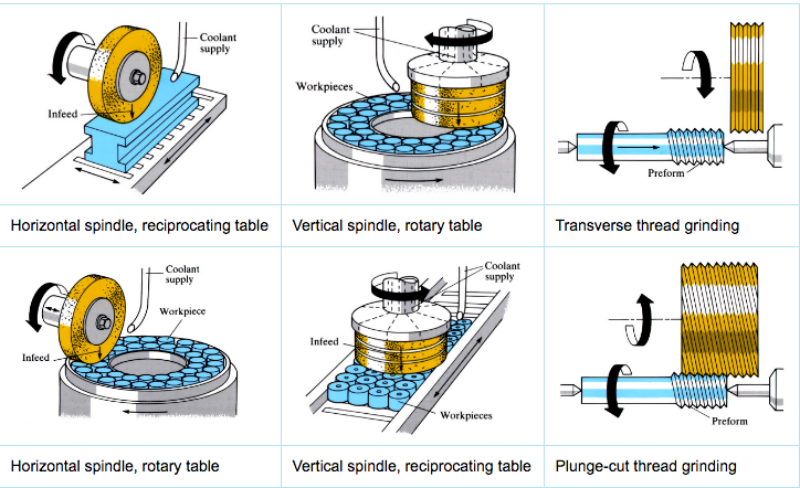
Manufacture:
- Selection of correct grinding wheel is essential to all processes and applications.
- Low stress grinding (LSG) uses wheel speeds of about 20 m s-1 and can usually be done on conventional grinding machines in any of the grinding modes.
- Most surface grinding operations use wheel speeds of 30–35 m s-1.
- High speed (high efficiency) grinding is a rapid metal-removing process using special wheels with speeds of 100 m s-1. Grinding machines must have special requirements such as rigidity, high work speeds, high power and special safety provisions.
- Depths of cut are small (cf. creep feed grinding, about 25 mm): roughing, 0.1–0.4 mm; finishing 0.01–0.025 mm; LSG, 0.005–0.0125 mm.
- Work (table) speeds depend on size, type and rigidity of work: LSG, 10–15 m s-1; surface 15–30 m s-1; cylindrical, 20-30 m s-1; internal, 20–60 m s-1.
- Cross-feeds depend on wheel width: roughing, 75–90% of wheel width rev-1; finishing, 10–25% of wheel width rev-1.
- Grinding ratios (volume of material removed/volume of wheel wear) depend on type of wheel, work speed, wheel speed, cross-feed, down-feed and grinding fluid. Grinding ratios vary from 2 to 200, although high grinding ratios frequently give rise to poor surface integrity.
- For form grinding wheels are dressed to shape using diamond dressing tools or by “crush dressing”.
Materials:
- Ferrous, non-ferrous, polymers and ceramics are ground, as long as workpiece is softer than the abrasive grit.
- High ductility metals have a tendency to clog the grinding wheels which then require frequent dressing.
- To grind hard materials a soft grade, fine-grained wheel should be used, whereas for softer metals a harder grain and coarser-grained wheel should be used.
Design:
- Surface roughness is mainly dependent on grit size, although the structure of the wheel, dressing and operating parameters also have an effect. Typical surface finish is 0.1–2 µm Ra. Roughing with coarse grit wheels can give a surface finish as high as 10 µm Ra, whereas finish grinding with fine-grit wheels can give values as low as 0.02 µm Ra.
- Tolerances vary greatly according to the grinding operations used:
Grinding operation Tolerances ± (mm) Production Precision Cylindrical grinding Diameters
0.0065
0.0025
Shoulders
Shoulder to shoulder
0.0065
0.0125
Traverse grinding to a shoulder
0.05
0.025
Corners and radii
External corners
Sharp
Sharp
Internal corner radii
0.125
0.065
Surface grinding
Reciprocating table grinder
Flatness
0.0050
0.0035
Thickness
0.0075
0.0035
Rotary table grinder
Flatness
0.0050
0.0025
Parallelism
0.0050
0.00125
Thickness
0.025 0.005 Internal grinding
Holes (using automatic sizing devices)
0.0065
0.00125
Face runout (squareness of shoulder to bore) 0.0065 0.00125 - Grinding forms and fillets usually require wheels with a grit size of 80 or finer to achieve radii less than 0.25 mm.
See Also: Centreless grinding and Creep feed grinding.
This article is a part of Manupedia, a collection of information about some of the processes used to convert materials into useful objects.
Rate and Review
Rate this article
Review this article
Log into OpenLearn to leave reviews and join in the conversation.
Article reviews